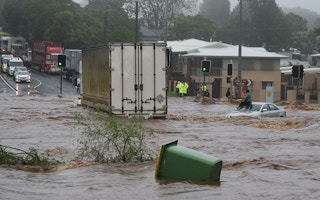Australian rain across much of the country is reaching an unexpected ferocity, and scientists who predicted a greater number of ever more intense rainstorms as the planet warms may have to think again—and think big.
A new study says the rate of rainfall in Australia during thunderstorms is, in fact, increasing twice or even three times beyond expectation and much faster than would be expected with global warming. The largest downpours arrive with the most extreme events.
And although climate change predictions long ago foresaw the danger of ever more intense storms, researchers have looked back over the last 50 years to show that this is already happening.
“
If we keep seeing this rate of change, we risk committing future generations to levels of flood risk that are unacceptable by today’s standards.
Seth Westra, professor, University of Adelaide
What they did not expect to find was that such rainstorms are much more intense than anything they had expected under a regime of global warming and climate change, driven by the profligate human use of fossil fuels.
“It was thought there was a limit on how much more rain could fall during these extreme events as a result of rising temperatures,” said Selma Guerreiro, an engineer at the University of Newcastle in the UK, who led the study.
“Now that upper limit has been broken, and instead we are seeing increases in rainfall, two to three times higher than expected during these short, intense rainstorms. This does not mean that we will see this rate of increase everywhere. But the important thing now is to understand why rainfall is becoming so much more intense in Australia and to look at changes in other places around the world.
“How these rainfall events will change in the future will vary from place to place and depend on local conditions besides temperature increases.”
She and her colleagues report in Nature Climate Change that they looked at what could be expected, under predictable conditions. One expectation is that as the air warms by 1°C, its capacity to absorb moisture increases by almost 7 per cent, which means with more warmth there will be more evaporation and more rainfall.
They looked over the records for the years 1966-1989 and 1990-2013 at data for daily and hourly rainfall – which should record the most intense downpours—from more than 100 weather stations. Between the two periods, global average temperatures increased by 0.48°C. They observed hourly extremes that were double, and even three times, the expected scale for any particular temperature rise.
Consistent predictions
That Australia is a continent of extremes, and a landscape that continues to deliver the unexpected, is no surprise. All climate models predict more extreme rainfall. Climate change has already been implicated in Australia’s catastrophic 2010 floods. Researchers have consistently predicted a stormier future for Australia, with ever greater temperatures.
One of the researchers, Seth Westra of the University of Adelaide, explicitly predicted rising rainfall five years ago. In the same year, researchers confirmed that so much rain had fallen on Australia in 2010 that global sea level actually dropped.
But the latest study does more than confirm recent certainties: it highlights the peculiar hazard that can be linked to storm intensity. The heavier and more focused the downpour, the greater the risk of urban flooding, landslips and potentially lethal flash floods. And although engineers and city planners expected to have to deal with more stormwater, what could happen is far worse than anything they are now prepared for.
“If we keep seeing this rate of change,” Professor Westra said, “we risk committing future generations to levels of flood risk that are unacceptable by today’s standards.”
This story was published with permission from Climate News Network.










